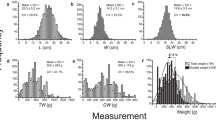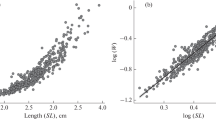Abstract
The biological meaning of the parameters a and b of the empirical and in fisheries science and management omnipresent relationship Weight = a * Length b is still unclear; the depicting body size trajectory has been associated thus far with body form and with food/energy considerations. When I analyzed a 116 species large and 36 years long subset of the port biosampling program of the US Virgin Islands fishery, Eastern Caribbean, using regression prediction intervals and fish life traits, I found out that the power law model is not a perfect fit due to individual variation. Concurrent stunting and starvation are generated at marginal values of the a and b parameters; their frequency is independent of fish body form and habitat type; dependent on species, trophic level and life stage; and changes the fundamental fish body size growth model from (log transformed) linear to curvilinear for three demo species. Also, variation in the parameter b could not be explained by trophic level, body form or habitat type. An alternative explanation is proposed, where b is the “accelerator” and a is the “break”; it expresses the correspondence of fish condition to environmental condition.

Similar content being viewed by others
Data availability
All data analyzed are available by the South East Fisheries Science Center, National Oceanic and Atmospheric Administration upon request (joshua.bennett@noaa.gov) or at https://www.fisheries.noaa.gov/inport/q?keywords=USVI.
References
Aho, K., D. Derryberry & T. Peterson, 2014. Model selection for ecologists: the worldviews of AIC and BIC. Ecology 95: 631–636.
Al Nahdi, A., C. Garcia de Leaniz & A. J. King, 2016. Spatio-temporal variation in length-weight relationships and condition of the ribbonfish Trichiurus lepturus (Linnaeus, 1758): implications for fisheries management. PLoS ONE 11: e0161989. https://doi.org/10.1371/journal.pone.0161989.
Appeldoorn, R., J. Beets, J. Bohnsack, S. Bolden, D. Matos, S. Meyers, A. Rosario, Y. Sadovy & W. Tobias, 1992. Shallow water reef fish stock assessment for the US Caribbean, NOAA Fisheries. Silver Spring, MD:
Bellwood, D. R., T. P. Hughes, C. Folke & M. Nyström, 2004. Confronting the coral reef crisis. Nature 429: 827–833. https://doi.org/10.1038/nature02691.
Bilici, S., A. Kaya & M. Y. Dörtbudak, 2016. A survey on Luciobarbus mystaceus (Pallas, 1814) by geometric morphometric methods depend on gender, age and season variations. Survey in Fisheries Sciences 3: 40–49. https://doi.org/10.18331/SFS2017.3.2.5.
Bohnsack, J.A. & D.E. Harper, 1988. Length-weight relationships of selected marine reef fishes from the southeastern United States and the Caribbean. NOAA, NMFS: Technical Memoir, NMFS-SEFC-215. https://repository.library.noaa.gov/view/noaa/3027/noaa_3027_DS1.pdf
Boukal, D. S., U. Dieckmann, K. Enberg, M. Heino & C. Jørgensen, 2014. Life-history implications of the allometric scaling of growth. Journal of Theoretical Biology 359: 199–207. https://doi.org/10.1016/j.jtbi.2014.05.022.
Burton, M. L. & J. C. Potts, 2015. Age, growth and natural mortality of coney (Cephalopholis fulva) from the southeastern United States. PeerJ 3: e825. https://doi.org/10.7717/peerj.825.
Choat, J. H., D. R. Robertson, J. L. Ackerman & J. M. Posada, 2003. An age-based demographic analysis of the Caribbean stoplight parrotfish Sparisoma viride. Marine Ecology Progress Series 246: 265–277.
Caribbean Fishery Management Council, 2017. US Virgin Islands Commercial Fishery Data Collection Programs. https://www.caribbeanfmc.com/After_the_Meeting_Documents/157th_After_the_Meet_Docs/8_CFMC_presentation_USVI_data_collection.pdf
De Robertis, A. & K. Williams, 2011. Weight-Length relationships in fisheries studies: the standard allometric model should be applied with caution. Transanctions of the American Fisheries Society 137: 707–719. https://doi.org/10.1577/T07-124.1.
Diana, J. S., 1987. Simulation of mechanisms causing stunting in northern pike populations. Transanctions of the American Fisheries Society 116: 612–617. https://doi.org/10.1577/1548-8659(1987)116%3c612:SOMCSI%3e2.0.CO;2.
Dikou, D., T. Corneille, K. Carmody, 2018. Life-traits based coral reef fisheries management – More support from the US Virgin Islands fishery. Poster presented at the 4th Guam coral reef symposium, March 27, 2018, Guam Bureau of Statistics and Plans. www.google.com/url?sa=t&rct=j&q=&esrc=s&source=web&cd=&cad=rja&uact=8&ved=2ahUKEwi1pJ-m-671AhXRSfEDHTy_DR8QjBB6BAgJEAE&url=https%3A%2F%2Fbsp.guam.gov%2Freports%2F&usg=AOvVaw02f9XlWKVYhmnSibbcn1dD
Dikou, D., T. Corneille & K. Carmody, 2021. Sustainability of a tropical, multispecies, multigear, coral-reef-associated fishery system is efficiently inferred with the direct use of long-term port biosampling length records and life-history traits, US Virgin Islands. Aquatic Conservation: Marine and Freshwater Ecosystems 31: 567–589. https://doi.org/10.1002/aqc.3047.
Duann, C., 1998. Nutritional and developmental regulation of insulin-like growth factors in fish. The Journal of Nutrition 128(Suppl. 2): 306S-314S. https://doi.org/10.1093/jn/128.2.306S.
Food and Agriculture Organization of the United Nations, 2019. Milk-fish growth. Growth: species profiles. www.fao.org/fishery/affris/species-profiles/milkfish/growth/en/
Froese, R., 2006. Cube law, condition factor and weight–length relationships: history, meta-analysis and recommendations. Journal of Applied Ichthyology 22: 241–253. https://doi.org/10.1111/j.1439-0426.2006.00805.x.
Froese, R. & C. Binohlan, 2000. Empirical equations to estimate various life history characters of fishes (Linf, Lmat, Lopt, tmax). FishBase. www.fishbase.org/Download/
Froese, R. & D. Pauly, 2014. FishBase. www.fishbase.org
Froese, R., A. C. Tsikliras & K. I. Stergiou, 2011. Editorial note on weight-length relations of fishes. Acta Ichthyologica et Piscatoria 41: 261–263.
Fruciano, C., C. Tigano & V. Ferrito, 2012. Body shape variation and colour change during growth in a protogynous fish. Environmental Biology of Fish 94(4): 615–622. https://doi.org/10.1007/s10641-011-9968-y.
Giacalone, V. M., G. Danna, F. Badalamenti & C. Pipitone, 2010. Weight-length relationships and condition factor trends for thirty-eight fish species in trawled and untrawled areas off the coast of northern Sicily (central Mediterranean Sea). Journal of IED Ichthyology. https://doi.org/10.1111/j.1439-0426.2010.01491.x.
Gobert, B., A. Guillou, P. Murray, P. Berthou, M. D. Oqueli Turcios, E. Lopez, P. Lorance, J. Huet, N. Diaz & P. Gervain, 2003. Biology of queen snapper (Etelis oculatus: Lutjanidae) in the Caribbean. Fisheries Bulletin 103: 417–425.
Guabiroba, H. C. & J.-C., Joyeux, 2018. Length-weight relationships for reef fishes in a southwestern Atlantic tropical oceanic island. Pan-American Journal of Aquatic Sciences 13(1): 84–87.
Hayes, D. B., J. K. T. Brodziak & J. B. O’Gorman, 1995. Efficiency and bias of estimators and sampling designs for determining length-weight relationships of fish. Canadian Journal of Fisheries and Aquatic Sciences 52: 84–92. https://doi.org/10.1139/f95-008.
Jackson, J., M. Donovan, K. Cramer & V. Lam, 2014. Status and trends of Caribbean coral reefs: 1970–2012, Global Coral Reef Monitoring Network, Washington DC, USA:
Jones, R. E., R. J. Petrell & D. Pauly, 1999. Using modified length–weight relationships to assess the condition of fish. Aquaculture Engineering 20: 261–276. https://doi.org/10.1016/S0144-8609(99)00020-5.
Kadison, E., E. K. D’Alessandro, G. O. Davis & P. B. Hood, 2010. Age, growth, and reproductive patterns of the great barracuda, Sphyraena barracuda, from the Florida Keys. Bulletin of Marine Science 86: 773–784. https://doi.org/10.5343/bms.2009.1070.
Karachle, P. K. & K. I. Stergiou, 2012. Morphometrics and allometry in fishes. In Wahl, C. (ed), Morphometrics InTech: 65–86.
Kerkoff, A. J. & B. J. Enquist, 2009. Multiplicative by nature: why logarithmic transformation is necessary in allometry. Journal of Theoretical Biology 257: 519–521. https://doi.org/10.1016/j.jtbi.2008.12.026.
Kimmerer, W., S. R. Avent & S. M. Bollens, 2005. Variability in length-weight relationships used to estimate biomass of estuarine fish from survey data. Transanctions of the American Fisheries Society 134: 481–495. https://doi.org/10.1577/T04-042.1.
King, M., 2007. Fisheries biology assessment and management, Wiley-Blackwell, Oxford:
Lapointe, B. E., R. A. Brewton, L. W. Herren, M. Wang, C. Hu, D. J. McGillicuddy Jr., S. Lindell, F. J. Hernandez & P. L. Morton, 2021. Nutrient content and stoichiometry of pelagic Sargassum reflects increasing nitrogen availability in the Atlantic Basin. Nature Communications 12: 3060. https://doi.org/10.1038/s41467-021-23135-7.
MacKenzie, D. 2019. The starving ocean. www.fisherycrisis.com/index.html
Mansano, C. F. M., B. I. Macente, K. Khan, T. MTd. Nascimento, EPd. Silva, N. Sakomura & J. B. K. Fernandes, 2017. Morphometric growth characteristics and body composition of fish and amphibians. In Pares-Casanova, P. M. (ed), New insights into morphometry studies. IntechOpen, London.
Marks, K. W. & K. D. Clomp, 2003. Appendix II fish biomass conversion equations. In Lang, J. C. (ed), Atlantic and gulf rapid reef assessment status of coral reefs in the western Atlantic: results of initial surveys, Atlantic and gulf rapid reef assessment (AGRRA) Program National Museum of Natural History, Washington DC: 625–630.
Meyers, P. J. & M. C. Belk, 2014. Shape variation in a benthic stream fish across flow regimes. Hydrobiologia 738: 147–154. https://doi.org/10.1007/s10750-014-1926-1.
Molina-Ureña, H. 2009. Towards an ecosystem approach for non-target reef fishes: habitat uses and population dynamics of South Florida parrotfishes (Perciformes: Scaridae). PhD Thesis, University of Miami.
Munro, J. L., 1983. Caribbean coral reef fishery resources, ICLARM-Manila, The Philippines:
Murawski, S. A. & J. S. Idoine, 1992. Multispecies size composition: a conservative property of exploited fishery systems? Journal of Northwest Atlantic Fishery Science 14: 79–85.
Newsom, T.J., 2017. Sample size issues and power. Psy 510/610 multilevel regression. web.pdx.edu/~newsomj/mlrclass/ho_sample%20size.pdf
NOAA-NMFS, 2017. www.fisheries.noaa.gov/inport/q?keywords=USVI
O’Brien, L., 2006. Trends in observed mean weight and length of several groundfish stocks. Northeast fisheries science center, woods hole, garm maturity and weight working group. archive.nefmc.org/press/council_discussion_docs/Mean%20Weight%20and%20Length%20Review%20OBRIEN_nov06.pdf
Opitz, S., 1996. Trophic interactions in Caribbean coral reefs, ICLARM-Makati City, The Philippines:
Pauly, D., Froese, R., Palomares, M.L., Stergiou, K. & C. Apostolidis, 2014. Fish online a guide to learning and teaching Ichthyology using the FishBase information system. Version 3. www.fishbase.in/FishOnLine/English/index.htm
Preston, S., 2000. Teaching prediction intervals. Journal of Statistics Education. https://doi.org/10.1080/10691898.2000.12131297.
Rana, R., Staron, M., Berger, C., Hansson, J., Nilsson, M. & F. Törner, 2013. Comparing between maximum likelihood estimator and non-linear regression estimation procedures for NHPP software reliability growth modeling. In: The Institute of Electrical and Electronics Engineers (ed.), Joint conference of the 23rd international workshop on software measurement and the 8th international conference on software process and product measurement. Ankara, Turkey, pp. 213–218.
Rasbash, J., Charlton, C., Browne, W.J., Healy, M. & B. Cameron, 2015a. MLwiN Version 2.32. Center for Multilevel Modeling, University of Bristol. www.bristol.ac.uk/cmm/software/mlwin/download/
Rasbash, J., Charlton, C., Browne, W. J., Healy, M., Cameron, B., 2015b. MLwiN version 2.32, University of Bristol, UK, Centre for Multilevel Modelling, Bristol.
Robinson, L. A., S. P. R. Greenstreet, H. Reiss, R. Callaway, J. Craeymeersch, I. de Boois, S. Degraer, S. Ehrich, H. M. Fraser, A. Goffin, I. Kröncke, L. Lindal Jorgenson, M. R. Robertson & J. Lancaster, 2010. Length–weight relationships of 216 North Sea benthic invertebrates and fish. Journal of the Marine Biological Association UK 90: 95–104. https://doi.org/10.1017/S0025315409991408.
Roff, D., 1983. An allocation model of growth and reproduction in fish. Canadian Journal of Fisheries and Aquatic Sciences 40: 1395–1404. https://doi.org/10.1139/f83-161.
Rothenberger, P., Blondeau, J., Cox, C., Curtis, S., Fisher, W.S., Garrison, V., Hillis-Starr, Z., Jeffrey, C., Kadison, E., Lundgren, I., Miller, W.J., Muller, E., Nemeth, R., Paterson, S., Rogers, C., Smith, T., Spitzack, A., Taylor, M., Toller, W. & Waddell, J., 2008. The state of coral reef ecosystems of the U.S. Virgin Islands. In: NOAA (ed.), The state of coral reef ecosystems of the United States and Pacific freely associated states: 2008. NOAA, Silver Spring, NOAA Technical Memorandum NOS NCCOS 73, pp 29–73. hppt://repository.library.noaa.gov/view/noaa/17794
Smith, M., D. Warmolts, D. Thoney & R. Hueter, 2004. The elasmobranch husbandry manual: captive care of sharks rays and their relatives, Ohio Biological Survey:
Voulgaridou, P. & K. I. Stergiou, 2003. Trends in various biological parameters of the European sardine, Sardina pilchardus (Walbaum, 1972), in the Eastern Meditteranean Sea. Scientia Marina 67: 269–280. https://doi.org/10.3989/scimar.2003.67s1269.
Wang, X., Y. Xue & Y. Ren, 2013. Length–weight relationships of 43 fish species from Haizhou Bay, central Yellow Sea. Journal of Applied Ichthyology 29: 1183–1187. https://doi.org/10.1111/jai.12200.
Ylikarjula, J., M. Heino & U. Dieckmann, 1999. Ecology and adaptation of stunted growth in fish. Evolution and Ecology 13: 433–453. https://doi.org/10.1023/A:1006755702230.
Acknowledgements
I thank the South East Fisheries Science Center, National Oceanic and Atmospheric Administration (joshua.bennett@noaa.gov) for the 1980–2015 data extracted from the USVI port biosampling monitoring program.
Funding
No funds, grants, or other support was received.
Author information
Authors and Affiliations
Corresponding author
Ethics declarations
Conflict of interest
The author has no relevant financial or non-financial interests to disclose.
Additional information
Handling editor: Grazia Pennino
Publisher's Note
Springer Nature remains neutral with regard to jurisdictional claims in published maps and institutional affiliations.
Supplementary Information
Below is the link to the electronic supplementary material.
Rights and permissions
Springer Nature or its licensor (e.g. a society or other partner) holds exclusive rights to this article under a publishing agreement with the author(s) or other rightsholder(s); author self-archiving of the accepted manuscript version of this article is solely governed by the terms of such publishing agreement and applicable law.
About this article
Cite this article
Dikou, A. Weight–length relationship in fish populations reflects environmental regulation on growth. Hydrobiologia 850, 335–346 (2023). https://doi.org/10.1007/s10750-022-05072-8
Received:
Revised:
Accepted:
Published:
Issue Date:
DOI: https://doi.org/10.1007/s10750-022-05072-8




